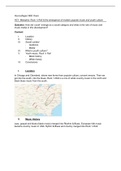Hoorcolleges Wild Years
HC1: Memphis: Rock ’n Roll & the emergence of modern popular music and youth culture
Question: How did ‘youth’ emerge as a social category and what is the role of music and
music media in this development?
Content:
I. Location
II. History
III. Social context
- Audience
- Media
IV. What is youth culture?
V. Youth music: Rock ’n Roll
- Black history
- White history
VI. Conclusions
I. Location
In Chicago and Cleveland, where new forms from popular culture, concert venues. Then we
get into the south, into the blues. Rock ’n Roll is a mix of white country music in the north and
black blues music from the south.
II. Music History
Jazz, gospel and blues (black music) merged into Rhythm & Blues. European folk music
became country music in USA. Rythm & Blues and country merged into Rock ’n Roll.
, III. Social context
Audience:
1. Baby boom US:
- During WW2 not many children were born because males had to fight and
were not home.
- Pyramid 1955: 12,7 m teenagers, 7,4% of the population.
- Pyramid 1965: 18,7 m teenagers, the base widens. There are far more young
people then 10 years ago. 9,3% of the population.
2. Extended schooling: much longer than previous generations.
- Figure: increase from 1940-2009. There are more people going to school for a
longer time. Much longer than previous generations.
-
3. Relative prosperity (for black & white kids):
- Figure: Development in income from lower 99% and top 1% in the USA.
Between 1940 and 1970 is an increase from income from the lower 99%.
Everything was becoming better after the war, people thought. People were
optimistic. After 1970 the increasing it stopped. The top income was steady
until 1980. After the 80 huge increase in income among the top.
- Sidenote: Graph doesn’t compare the 1% top richest and 1% poorest.
- What did the 99% people do with the money?
They went out to live in suburbs. People bought cars (working class).
They build new houses in suburbs.
Consequences prosperity: The inner cities of bigger cities were
populated by poor people and in the US this is very often the same
were now the area in which black people lived.
, -
4. Racism and segregated world:
- They lived in segregated worlds. They would not mix. Different quarters,
schools, bus, theatres etc. The youth grew up in a segregated world when
racism was normal.
- Example: Rosa Parks
Preliminary conclusions 1:
There were many more young people in the ’60 and they grew up in prosperous area.
But they lived in segregated worlds of black and white. Going to school they
developed a sense of being ‘’young’’. They are different than kids and adults.
Media: inventions
1. 45 RPM: single, 8-track: Very handy. It wouldn’t break, it was cheap. You could take
it places if there was a grammaphone. You could easily play music. Cassette desk
was very handy in your car.
2. Juke box: You could stack up to 50 or 100 in a juke box. Sound music was great
because it was electrified. From 1950 was the golden age of the juke box.
3. Chicago: AM radio: Music was played on radio stations that you could listen to. Very
important in the 40 and 50 new radio stations came in, also for black audiences.
- Example:
Al Benson, DJ from Chicago (1955): Listening to him was like listening
to someone from the south, from home. Because a lot of black people
moved to the north, he was very popular.
Alan freed, Cleveland (1951): White kids buying black music. So why
not have a show with black music? He, as a white man, played black
music to white audience.
‘’Jumping’’ George Oxford KBAN San Francisco (1955), Robin
Seymore WKMH Dearbom (1956)
4. Concert halls: There would be black music in concert halls. Young people started to
listen to black music in the 20 when swing jazz was popular, but this increased
among white people in the 50.
- Example: Moondog show. This was like a concert form for rhythm and blues,
jazz, country etc. All sorts of music. Huge success. First rock/pop concert.
Was closed down by fire brigade.
5. Film, TV:
, -Film: Wilde One, main characters that were rebels (Rebel without a Cause
with James Dean).
- TV: ABS as off 1957. It was white audiences dancing to black music and black
bands. Till 1963, the white and black audiences were segregated. Even
though whites listened to black music, they still were segregated.
6. Record companies & charts: they had to be made for the new music.
- Majors: RCA Victor, Columbia, Decca, Capitol, MGM, Mercury.
- Minors: Sun, Chess, Atlantic, King, Imperial. they produced black music
before the majors. The first to record and marked this new type of music, the
new rock and roll.
Sun studio Memphis: Elvis Presley recorded his music here.
- 1936 Billboard Charts: The top 50 hits. It was a new phenomenon. On a
weekly basis they would scan the popular tracks.
Rhythm & Blues (race music) chart
Country & Western chart
Pop chart since 1936: wasn’t divided by race. It wasn’t segregated.
Preliminary conclusions 2:
Media, local and nationwide, cater to the ‘’needs’ of a new group of consumers:
Youth. New forms of radio, film, dancehalls, concert venues emerged for the Youth.
Vehicles: If you were the youth, the hamburger joints you would go to with your car
and meet with other people of your age and play music. Cars and motorcycles were
really important to bring them together.
Fashion: Fashion for youth developed.
IV. What is youth culture?
Youth culture = A groups distinctive way of life, including its beliefs and values, its customs
and its art and technologies. It’s about how they behave. What they produce (music etc.).
Now it includes technologies, since 2012.
Formula Youth culture:
PE + W = YC
- Prolonged education + wealth = Youth Culture
- Prolonged education: The youth went to school longer, and got a sense of
themselves, different than kids and adults. If you put together same age






